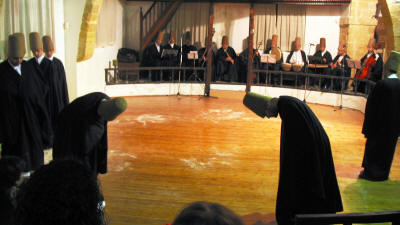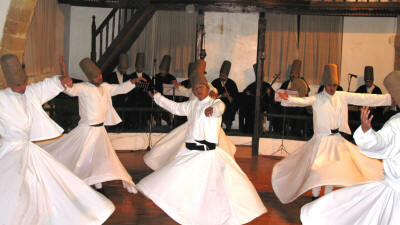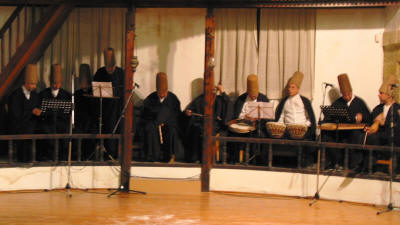Mevlevi Sema Ceremony
 |
| The Sema Ceremony |
Mevleviye are known for their famous practice of whirling dances. At their dancing ceremonies, or Sema, a particular musical repertoire called ayin is played. This is based on four sections of both vocal and instrumental compositions using contrasting rhythmic cycles and is performed by at least one singer, a flute-player (neyzen), a kettledrummer and a cymbal player. The oldest musical compositions stem from the mid-sixteenth century combining Persian and Turkish musical traditions. The repertoire was continuously broadened, and the first notations were made from the early twentieth century onwards.
 |
| Whirling Dervishes |
Dancers would receive 1,001 days of reclusive training within the mevlevihane, a sort of cloister, where they learnt about ethics, codes of behaviour and beliefs by living a practice of prayer, religious music, poetry and dance. After this training, they remained members of the order but went back to their work and families, combining spiritualism with civic life.
Following a recommended fast of several hours, the whirlers begin to rotate on their left feet in short twists, using the right foot to drive their bodies around the left foot. The body of the whirler is meant to be supple with eyes open, but unfocused so that images become blurred and flowing.
 |
| The Sema Musicians |
The Sema takes place in a large circular-shaped room that is part of the mevlevihane building. As a result of secularisation policies, all mevlevihane were closed in 1925. Many practitioners kept their tradition alive in private gatherings, and thirty years later, the Turkish government began to allow performances again, though only in public. From the 1990s, restrictions were eased and private groups re-emerged who try to re-establish the original spiritual and intimate character of the Sema ceremony.
During the thirty years of clandestiny, transmission focused rather on music and songs than on spiritual and religious traditions because the latter were forbidden. Today, the performances have been mostly deprived of their religious significance, with the consequence that they are no longer performed in their traditional context but in front of tourist audiences.
The length of the sema ceremony has been truncated to cater commercial requirements, and a number of musical styles related to the rituals are in danger of disappearing altogether.
Text copyright UNESCO 2005
Photos copyright www.whatson-northcyprus.com